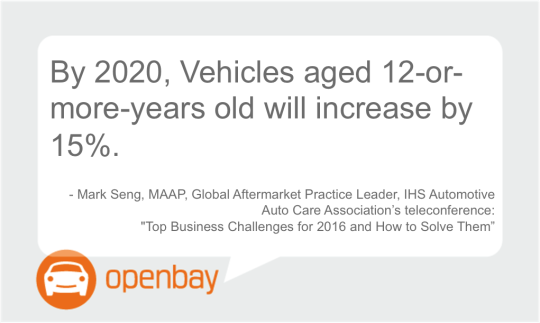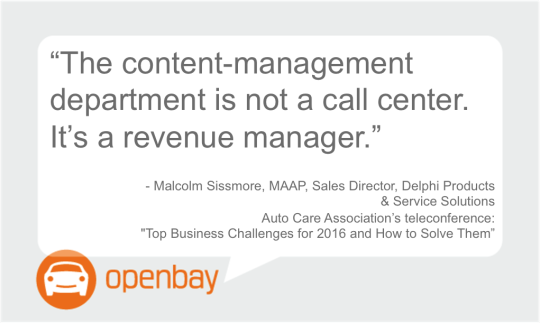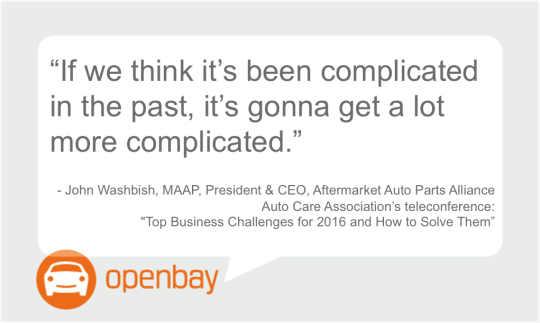Today, the Auto Care Association hosted a fascinating teleforum on the auto care industry called “Top Business Challenges for 2016 and How to Solve Them” with the following panelists:
- John Washbish, MAAP, President & CEO, Aftermarket Auto Parts Alliance, Inc.
- Mark Seng, MAAP, Global Aftermarket Practice Leader, IHS Automotive
- Malcolm Sissmore, Sales Director, Delphi Products & Service Solutions
Here are the notes we’d taken on some interesting trends, facts and challenges for the auto care industry in the years ahead.
FACTS
- The average age of the U.S. vehicle fleet has increased 17% in the last ten years.
- The average length of vehicle ownership for new and used vehicles has increased 60% in the last ten years.
- 75% of aftermarket auto repair is performed by independent auto repair shops, while 25% of the business lives with dealerships.
- Over the next five years, hybrids and electrics will increase, but not at a great rate within the next 5-10 years. Those vehicles are concentrated largely in pockets, as long as government rebates exist.
- “In the U.S., there are 1.1 registered vehicles for everyone over 16-years old. We have more cars than we have licensed drivers,“ said John Washbish, citing IHS research.

TRENDS
- The “aftermarket sweet spot” refers to those vehicles that are driving the most aftermarket repairs. In 2015, we view vehicles aged 6-11 years old to be within that “sweet spot,” but that will change. By 2020 ,there will be about 76 million units of vehicles aged 16+ years.
- Between 2015-2020:
- The number of new-to-5-years old vehicles will increase by about 24%
- Vehicles that are 6-11-years old will decline by about 11%
- Vehicles aged 12-or-more-years old will increase by 15%.
- Imports are growing. Today, 57% of vehicles on the roads in the U.S. are domestic. By 2020, that will be reduced to 53% domestics. Imports will grow from 43% to 47% – there are now about 111 million imported vehicles on U.S. roads, and by 2020, that will look more like 122 million units.
- There’s a trend toward large franchise auto repair businesses, which have smaller shops rolling up into them. That’s a good opportunity for profitable businesses on the service/seller-side.
- The aftermarket world is going online, and the marketplace is changing. Parts are being sold online, service is being sold online.
- By 2020, 80-90% of all new vehicles will have embedded telematics.
- There will be major changes in powertrains. Turbochargers have increased in popularity, and you’ll see that explosion continue. 4-cylinder turbos are delivering manufacturers with the fuel efficiency they need, without having to rely on hybrid and electric vehicles.The trend toward turbos is favorable for the aftermarket, noted Malcolm Sissmore, because “turbochargers require spark plug changes about 2-3 times more often than naturally aspirated” vehicles. “At the same time, those little engines have a lot being asked of them, and could see premature failures, and if that happens out of warranty, that’s also good for the industry.”
- “China is an explosive market, where 4.3-years is the average age of a car. There’s only one car for every 117 people. If you want to do something new, go to China,” said Washbish, citing IHS research.
- E-tailing: “It will go in that direction,” said Seng. “In this world, data is king, more so than it is now. Information on the supply chain, up-to-date pricing, discounts, pictures, and all the stuff that sells your brand” beyond what competitors offer, is key.“The content-management department is not a call center. It’s a revenue manager,” said Sissmore, noting that Delphi ensures it has pictures, specs, 3D images – “It’s going out in all sorts of forms.”

CHALLENGES
The Shifting Fleet
- By 2020, it will have to provide parts and service for 76 million vehicles aged 16+ years old.
- By 2020, there will be a shift toward more domestic vehicles. Will those shops that typically service domestic vehicles be ready, or perceived as ready, to service import vehicles? Training and marketing may be necessary.“If you only work on GM, Ford or Chrysler, the guy with a Jag might not come to your shop,” said John Washbish. “You might have to change your complexion. … Expand your wings to look more import friendly.”
Telematics
- As telematics are increasingly embedded in new vehicles, the auto care industry faces a dilemma similar to that posed around the “Right to Repair” bill – who has access to that data? “It’s important that the aftermarket industry has access to this. That could be an opportunity,” said Sissmore, who noted that The Auto Care Association is actively working on this, as it had worked toward approval of the “Right to Repair.”“From the shop perspective, the ‘connected car’ world is going on today. It’s getting bigger, and proliferating in the future,” said Sissmore, who described a check-engine light being read once the vehicle’s in the shop. “The next step is that the shop will have that code remotely.”
- Training on telematics will be critical. Seng compared the change to the aftermarket in the 1980s, when we went from carburator to fuel-injected vehicles, and had to prepare the automotive techs, advising “make sure consumer knows that they can bring these new, sophisticated vehicles [to independent shops]. They might think [that the cars are] so sophisticated that the shops can’s handle it.” Training techs in telematics, having the right parts on the shelf, and marketing your shop’s competency to service sophisticated newer vehicles will be increasingly important. “I’m bullish on the aftermarket to be able to do it again with this new technology,” said Seng.
Inventory
Inventory selection and control will become increasingly important and key to success. “If we think it’s been complicated in the past, it’s gonna get a lot more complicated,” said Washbish. As the world moves online, people will want parts in 30 minutes or less. There are good competitions – they’ve got same issues with parts, and they may need fulfillment partners.”

Shortage of Techs
With millions of retiring shop techs, there aren’t millions taking their places. The Auto Care Association has taken a proactive approach with its newly created job board. And universities, such as Northwood, are focusing on STEM courses, working with manufacturers. The industry must remain active in its approach to filling the pipeline of automotive technicians.
***
We hope you enjoyed our brief recap of the hour-long teleconference. .
If you haven’t already, check out Openbay, the online marketplace for auto repair. We’re proud members of the Auto Care Association, and send our biggest thanks to them for encouraging such useful dialog on industry trends.
Shops – Take the first step toward preparing for your future now.
Save upwards of 25% on
car repair and maintenance services with Openbay+

